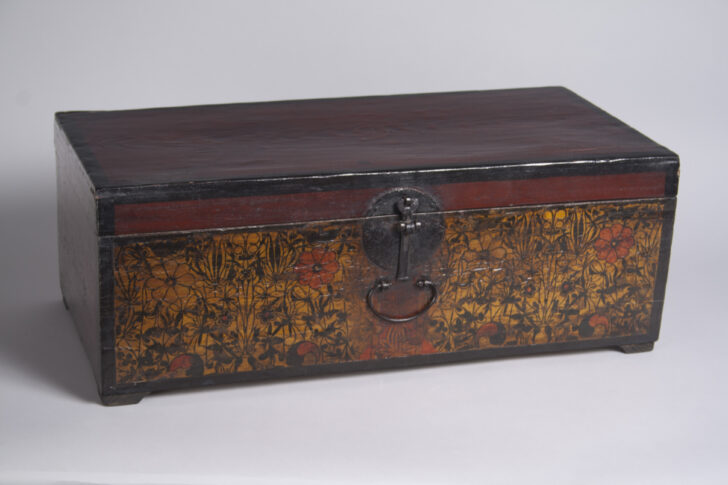Wedding Chest with Papered Front
Korean

Description
Gallery Rotation Winter 2014
Wedding chest with papered front
Korea, Joseon period (1392–1910)
Late 19th century
Wood and lacquer with painted paper on front
Gift of Bruce and Inta Hasenkamp and museum purchase made possible by Elder and Mrs. Sang-Yong Nam, 2004/1.313
The small size and feminine motifs of this lacquered box suggest it was probably intended to store the fabrics and jewelry used for a ceremonial game played at a wedding. In that game, the groom’s best friend would bring a wedding box to the bride, from whom he would then, in a humorous way, try to extract payment. Inside the box would be fabric, jewelry, and symbols of fertility such as silk thread, silkworm cocoons, and red paper. After the ceremony, the box would be kept in the woman’s private quarters.
Subject Matter:
Box likely used in traditional game played in relation to Korean wedding. In the game, the groom’s best friend would bring a wedding box to the bride, from whom he would then, in a humorous way, try to extract payment. Inside the box would be fabric, jewelry, and symbols of fertility such as silk thread, silkworm cocoons, and red paper. After the ceremony, the box would be kept in the woman’s private quarters.
Physical Description:
A short, long wooden chest with a papered front. The metal fittings on the chest are vert dark, and the front latch is attached to the chest with a circular piece of metal, and the latch itself is a thin piece of metal placed vertically. A small metal handle is located below this. The wood is a dark red color, and the papered front depicts flowers, with the predominant color being yellow. Orange is also used in some of the flowers, and on the circular shapes spaced along the bottom of the image. The outlines of the flowers and other images are painted in black.
This chest is papered over wooden frame. It has been repaired following partial damage to the rear hinges, the base, front panel and the paper decoration on the left and the right. The wooden frame is joined by butt joints and not miter joints, following the trend which was popular during the Japanese annexation of the Korean Peninsula. The box is therefore assumed to have been produced at this time, then repaired later. None of its original paper decoration remains. Paper decorations should be done with cut-out paper, but those attached to this chest are printed.
[Korean Collection, University of Michigan Museum of Art (2017) p. 273]
Usage Rights:
If you are interested in using an image for a publication, please visit https://umma.umich.edu/request-image/ for more information and to fill out the online Image Rights and Reproductions Request Form.